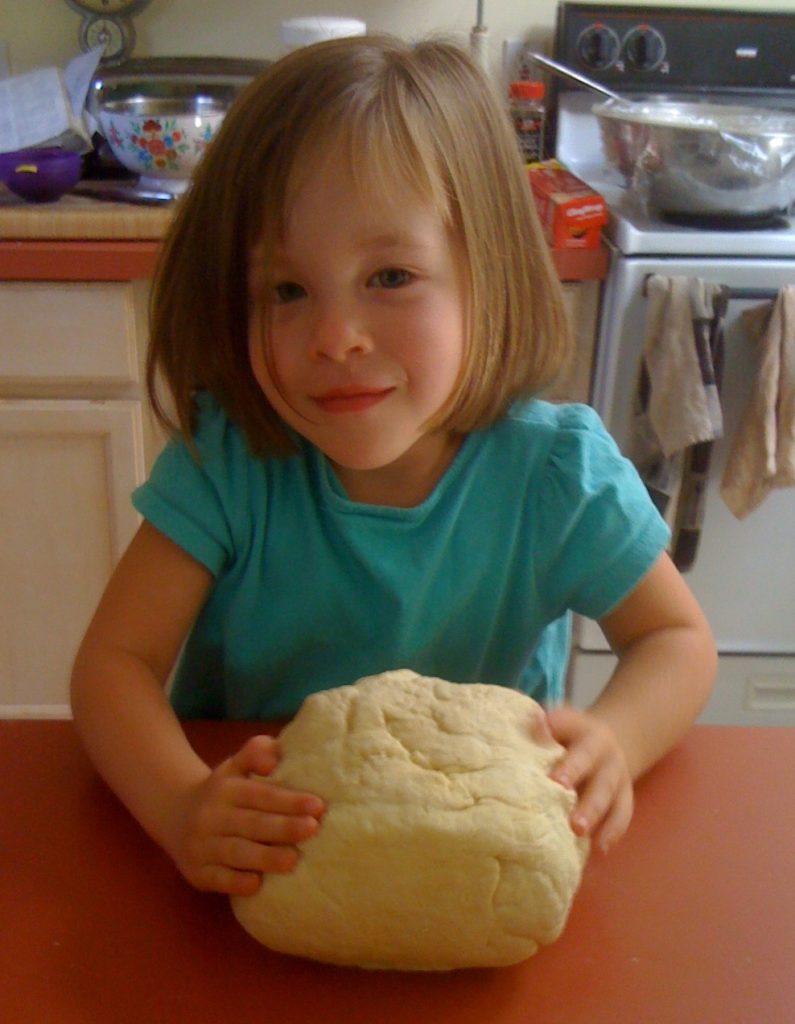
As I lightly dust the counter, a small plume of flour creates a momentary cloud of dust in the air before settling on the counter, the floor, the front of my apron. I’m blocking out the commotion from the day, seeking a meditative moment that will help relieve some stress, calm my mind and create something delicious for the family.
Hands down, bread baking is a favorite tradition in our household. It’s one that allows us to reap so many benefits – monetarily, nutritionally, and emotionally. It’s the emotional benefit I’m thinking about — from the aroma and taste of freshly baked bread, to the tactile sensation I experience when making bread. And it is the tactile sensation that truly pulls me in.
The Power of Touch
The power of touch is unmistakable. Using our hands activates the brain, enhancing our attachment to who, and what, we touch. It provides a sense of connectivity, activating the brain . So, when we are kneading, we activate the brain, creating a sensual connection with the dough.
Of course you can use a stand mixer to knead your dough, but think about it, when we make things with our hands, we feel effective, a sense of pride and satisfaction. Most of our meals are made from scratch, but it is our bread baking that brings the biggest benefits.
Engage yourself in the process of making dough – fully by hand. It may not be the way you choose to make it every time, but once in a while, indulge in the hands-on method that provides you with the benefits of touch.
Here is one of our most-used recipes for bread.

White Loaves
This is our sandwich bread, our toast bread, our snack bread . . . we love it! The recipe is from Baking with Julia, a well—used cookbook by Julia Child. Her recipe includes instructions for using a stand mixer to knead the dough, we have modified to knead by hand.
- 2-1/2 cups warm water
- 1 Tbsp active dry yeast
- 1 Tbsp sugar
- 7 cups bread flower, or unbleached all-purpose flour
- 1 Tbsp salt
- ½ stick unsalted butter at room temperature
Pour ½ cup of the water into a large bowl, sprinkle in the yeast and sugar, and whisk to blend. Allow the mixture to result until the yeast is creamy about 5 minutes.
Add remaining 2 cups water and about 3-1/2 cups flour to the yeast, and begin incorporating together with a wooden spoon.
Slowly add additional 3-1/2 cups flour, kneading after each small addition. If dough does not come together, add a bit more flour, a tablespoon at a time, until it does.
Add salt and continue to knead for about 10 minutes, until the dough is smooth and elastic.
When thoroughly mixed, add the butter a tablespoon at a time, and knead until incorporated. The dough may come apart with the addition of the butter, kneading will bring it back together.
Turn the dough out onto a lightly floured work surface and shape it into a ball. Place it in a large buttered or oiled bowl, turn dough around to cover the surface with the butter or oil, cover the bowl tightly with plastic wrap, and let the dough rest at room temperature until it doubles in bulk, about 45 minutes to 1 hour.
Butter 2 loaf pans and set aside.
Deflate the dough and turn it out onto a lightly floured work surface. Divide the dough in half and work with one piece at a time. Using the palms of your hands and fingertips, or a rolling pin, pat the dough into a large rectangle about 9 inches wide and 12 inches long, with a short side facing you. Starting at the top, fold the dough about two-thirds on the way down the rectangle and then fold it again, so that the top edge meets the bottom edge. Seal the seam by pinching it.
Turn the roll so that the seam is in the center of the roll, facing up and turn the ends of the roll in just enough so that it will fit in a buttered loaf pan. Pinch the seams to seal, turn the loaf over so that the seams are on the bottom, and plum the loaf with your palms to get an even shape. Drop the loaf into the pan, seam side down and repeat with the other piece of dough.
Cover the loaves with oiled plastic wrap, and allow them to rise in a warm place until they double in size again, growing over the tops of the pans, about 45 minutes.
While the loaves rise, center a rack in the oven and heat to 375 degrees F.
When the loaves have fully risen, bake them for 35-45 minutes, or until they are honey-brown and I instant read thermometer plunged into the center of the bread, measures 200 degrees F.
Remove the loaves from their pans as soon as they come from the oven and cool on racks.





